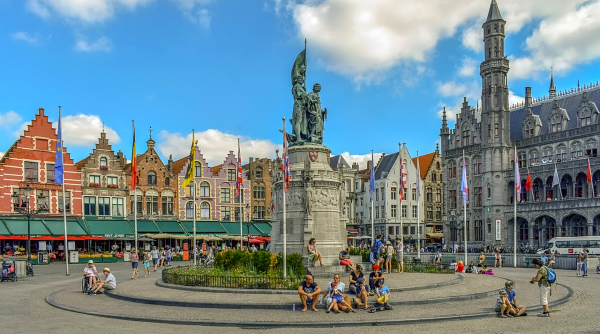Belgium may be a small country, but it packs a big punch when it comes to history, architecture, and, of course, food. Known for its medieval cities, world-class chocolate, craft beers, and waffles, Belgium offers a rich cultural experience in the heart of Europe. Whether you’re exploring the cobblestone streets of Bruges or admiring the Art Nouveau architecture of Brussels, Belgium has something for everyone.
What Tourists Can Expect
Belgium is a country where modernity meets tradition. Expect charming medieval towns, Gothic cathedrals, bustling markets, and lively cafés. The country is home to a mix of French, Dutch, and German influences, making it a culturally diverse destination. Most Belgians speak multiple languages, and English is widely understood, making communication easy for tourists.
With a well-developed train system, it’s also simple to travel from one city to another, so you can see much of the country in just a few days.
Best Time to Go
The best time to visit Belgium is during the spring (April to June) or fall (September to October). These seasons offer mild weather, fewer tourists, and vibrant colors in the parks and countryside. Springtime brings blooming flowers, especially in Brussels’ Royal Greenhouses.
Summer (July and August) is the peak tourist season, with warmer weather and plenty of outdoor events and festivals, but expect more crowds and higher prices. Winter (November to February) can be cold and rainy, but the Christmas markets and festive atmosphere in cities like Brussels, Ghent, and Bruges make it an appealing time for a winter getaway.
Currency
Belgium uses the Euro (€). Credit cards are widely accepted in hotels, restaurants, and stores, but smaller vendors and local markets may prefer cash. ATMs are easy to find, especially in larger cities like Brussels and Antwerp.
Weather
Belgium enjoys a temperate maritime climate, with moderate temperatures throughout the year. Summers are warm, with average temperatures ranging from 18°C to 25°C (64°F to 77°F). Winters can be chilly, with temperatures between 0°C and 6°C (32°F to 43°F), and rain is common year-round. Spring and fall offer mild, pleasant weather perfect for sightseeing.
What to Pack
- Layers: The weather can be unpredictable, so pack layers like sweaters, jackets, and scarves, especially in fall and winter.
- Comfortable shoes: Belgium’s cities are best explored on foot, and many areas have cobblestone streets.
- Rain gear: An umbrella or raincoat is essential, as rain can occur at any time.
- Casual yet stylish clothing: Belgians are fashion-conscious, so dress in smart-casual attire, especially for dining out.
- Portable charger: With all the photo ops in Belgium, you’ll want to keep your phone charged for capturing moments!
Where to Stay
Belgium offers a variety of accommodation options, from luxury hotels to charming guesthouses.
- Brussels: As the capital, Brussels is a great base for exploring Belgium. Stay at The Hotel Brussels, a sleek, modern hotel with panoramic views, or Hotel Amigo, a luxury option just steps from the famous Grand Place.
- Bruges: For a fairytale experience, stay in Bruges, a medieval city with canals and cobblestone streets. The boutique Hotel de Orangerie offers elegant rooms in a 15th-century building along the canal.
- Ghent: A less-touristy but equally charming city, Ghent offers both modern and historic appeal. 1898 The Post is a unique, luxurious hotel set in a former post office, offering a blend of history and comfort.
Best Things to See and Do
- Explore Brussels’ Grand Place
The heart of Brussels, the Grand Place is one of Europe’s most beautiful squares, surrounded by ornate guildhalls and the towering Town Hall. Don’t miss the Manneken Pis, the famous statue of a little boy, or the Royal Palace. Brussels is also home to fantastic museums, including the Magritte Museum and Musée des Beaux-Arts. - Tour the Canals of Bruges
Often referred to as the “Venice of the North,” Bruges is a UNESCO World Heritage city filled with medieval charm. A boat tour of the canals is a must-do for stunning views of the city. Be sure to visit the Belfry of Bruges, climb its 366 steps for panoramic views, and stroll through the Burg Square. - Visit Ghent’s Gravensteen Castle
Ghent is a lively university town with a fascinating mix of old and new. Visit Gravensteen Castle, a medieval fortress with a rich history, and explore the city’s vibrant arts scene. Don’t miss St. Bavo’s Cathedral, home to the famous Ghent Altarpiece by the Van Eyck brothers. - Taste Belgian Chocolate in Antwerp
Known as the diamond capital, Antwerp is also a hub for chocolate lovers. Take a walking tour of the city’s top chocolate shops, or visit The Chocolate Line, one of Belgium’s most famous chocolatiers. Antwerp also boasts impressive fashion and art scenes, with the Royal Museum of Fine Arts and ModeMuseum (Fashion Museum) being top attractions. - Enjoy Belgian Beer and Waffles
Belgium is famous for its beer culture, with hundreds of varieties and breweries to explore. Visit a traditional beer bar like Delirium Café in Brussels, which boasts over 2,000 beer choices. And don’t forget to indulge in Belgium’s other culinary delights—sample Belgian waffles from a street vendor or enjoy them at a café with powdered sugar, whipped cream, or chocolate. - Explore the Ardennes
For nature lovers, the Ardennes region in the southeast of Belgium offers outdoor activities like hiking, cycling, and kayaking. The area is also home to charming villages, ancient castles, and the Caves of Han, one of the largest cave systems in Europe.
Must-Visit Restaurants
- Comme Chez Soi (Brussels)
For a fine dining experience, Comme Chez Soi is a Michelin-starred restaurant in Brussels offering exquisite Belgian and French cuisine. The elegant setting and expertly prepared dishes make it a perfect choice for a special night out. - De Stove (Bruges)
Located in the heart of Bruges, De Stove is a cozy, family-run restaurant known for its fresh, seasonal ingredients and creative Belgian dishes. The intimate setting and friendly service make it a local favorite, and their seafood dishes are particularly popular.
Final Tips
- Public transportation: Belgium has an excellent train system, making it easy to travel between cities. Brussels is a major hub with connections to the rest of Europe, so consider taking day trips to Bruges, Ghent, or Antwerp.
- Try the local treats: In addition to chocolate, beer, and waffles, don’t leave without trying frites (Belgian fries) served with a variety of sauces, and moules-frites (mussels and fries), a popular Belgian dish.
- Cultural etiquette: Belgium is polite and reserved. Always greet shopkeepers and waiters when entering a business, and say “thank you” when leaving.
Whether you’re strolling through the medieval streets of Bruges, tasting world-renowned chocolates in Antwerp, or enjoying the grandeur of Brussels, Belgium offers a rich cultural tapestry for every type of traveler.
Image by Dimitris Vetsikas from Pixabay


